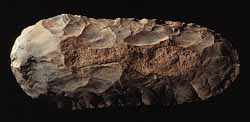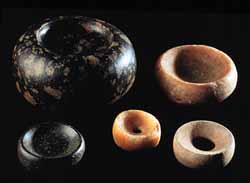
 |
Mississippian hoe, unknown source. | |
|
Plant cultivation required a variety of tools including hoes to till the ground before planting and for weeding. Mississippians made hoes out of large freshwater mussel shells, stone, and occasionally out of the shoulder blade bone of white-tailed deer. |
||
Woodland people used stone hoes to cultivate native plants. Mississippian people used the same tool, but it is often a different shape and sometimes made from a different stone (see Trade above). In large part, however, the type of tools used by Woodland people remained in use during the Mississippian period. Chipped stone hide scrapers, knives, and drills are common at Mississippian sites. Wood working tools such as celts are found at both Woodland and Mississippian sites.
At Cahokia, near East St. Louis, archaeologists found small microdrills, a tool not often seen in Woodland sites. Apparently, microdrills were used in the production of freshwater and marine shell beads and other ornaments.
Mississippians also used a variety of grinding stones to process plant foods.
 |
Discoidals, western Illinois. |
Recreational objects
Thick, polished stone disks-made by slowly pecking away the surface of one stone with another, harder stone-first appear during the Late Woodland. These objects, called discoidals, are more common at Mississippian sites. Based on historical accounts, the discoidal or chunkey stone, was rolled along the ground. Two game contestants would throw sticks at the stone in an attempt to knock it over or to come close to where the stone would eventually stop.
|
|
Copyright © 2000 Illinois State Museum